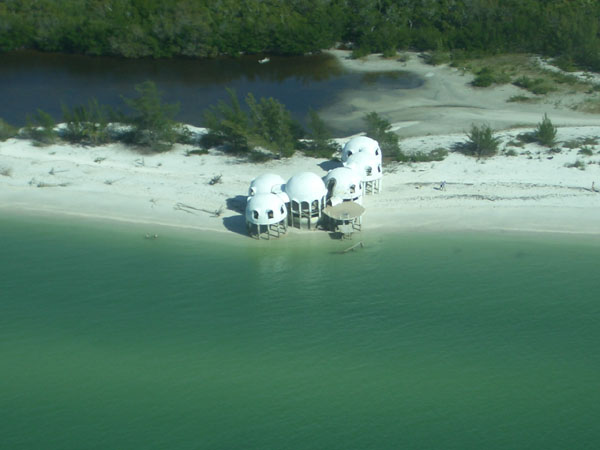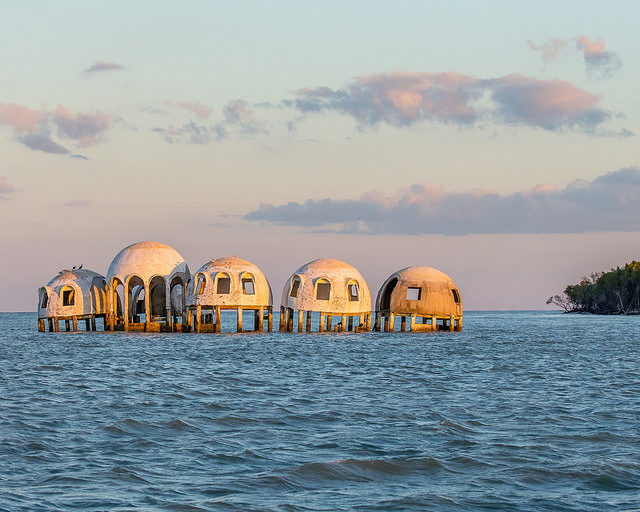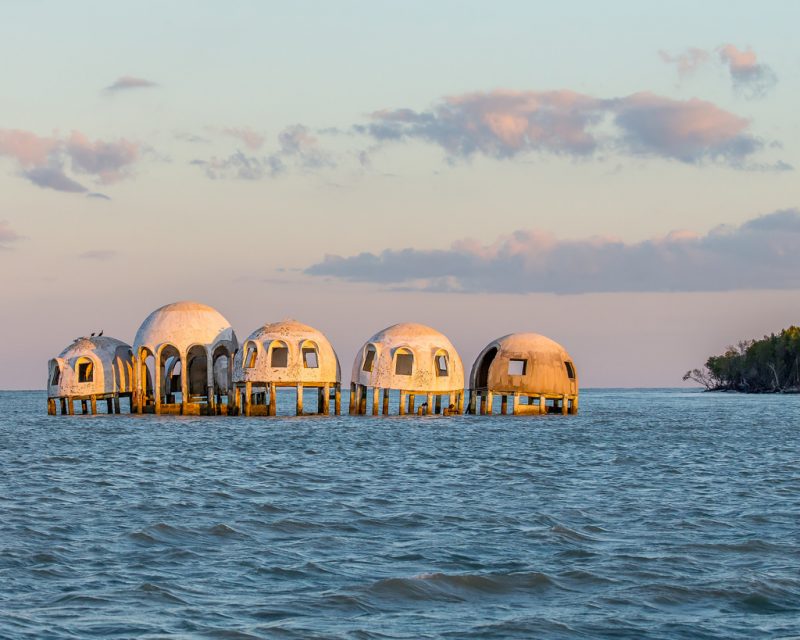Caxambas Island, south of Marco Island in Cape Romano, is one of the Ten Thousand Islands of Collier County, Florida. It was once the site of a beautiful domed house built in 1980, by retired oil producer Bob Lee.
Lee’s intent was to build a vacation home for his family. During 1978 and 1979, he was surveying land and purchased the best spot possible on which to build his futuristic home. To catch any faults, he may have overlooked in his design; Lee first built a full-scale model that still stands in Gatlinburg, Tennessee.

In 1980, Lee began construction of the white concrete domed structure. His personal barge brought the metal dome forms, concrete mixers, and fresh water for making the concrete to the building site. There were six parts to the house, each connected to each other and domed, and some of the parts had two stories. When completed, the living area measured 2,400 square feet, including three bedrooms and three bathrooms, the main living room, a kitchen, a den, and a sunroom.
Lee planned to make the residence self-sustainable. The concrete was made from sand from the surrounding beach, solar panels were used for electricity, and the dome shape of the roofs allowed rainwater to flow directly into gutters that drained into a 23,000-gallon cistern. The water was then filtered and pumped back into the house. The dome form also made the house nearly hurricane proof. The windows reached from the ceiling to the floor and let in plenty of light and fresh air. Carpet and ceramic tiles were used for flooring, and the inside pillars that held up the dome gave the home a Greek style.
Heaters, invented by Lee himself, provided the heat that ran through the floors on chilly nights. Lee believed that corners were wasted space; his domes provided an open space and gave the illusion of a larger room.
The seclusion of the island was perfect for Lee and his family, who enjoyed everything the sea had to offer while they lived in their luxurious home. The house had satellite TV, a hot tub, telephone service, air conditioning, a custom-built refrigerator, and solar water heaters imported from Israel. Several of the domes built on pillars allowed for a shaded outdoor living.

When the house was completed in 1982, it was appraised at $1.5 million. Lee and his wife, Margaret, named their new home Seascape.
In 1984, the Lees sold the house. Three years later, the new owners found themselves in financial trouble, so, in 1987, the Lees repossessed the home. Bob and Margaret moved back in, making it their main residence with their daughter Jane, her daughter, and their grandson, Mike.
They remodeled the interior and lived there until Hurricane Andrew hit in 1992. The home’s walls and foundations survived with no issues, but the interior was destroyed when the windows blew out. The Lees left the newly-uninhabitable home in 1992.
When it was originally built, the house stood well over twenty feet from the beach. The hurricane and natural erosion had caused the island to change its shape, and the beach started encroaching on the property in 2004. A year later, Naples resident John Tosto bought the home and land for $300,000, with the intention of moving the domes further away from the water and renovating the interior.
When he turned the property over to Tosto, Lee advised him to construct a sea wall to fight the eroding coastline, but given his plans to move the structure, Tosto decided against the wall.
Shortly after Tosto purchased the property, Hurricane Wilma hit Florida, further eroding the coastline and destabilizing the house’s foundation. Tosto boarded up the home’s windows and continued with his plans to move the house. The U.S. Army Corps of Engineers, the Department of Environmental Protection, and the Collier County Code Building and Enforcement Departments all required building permits that Tosto was unable to obtain.
In 2007, the Collier County Code Enforcement Board decided the structure was unsafe and gave Tosto two years to either demolish the house or remove it entirely. He was fined $187,000 for noncompliance, but the county offered to drop the fine if Tosto completed the demolition in a timely fashion. Having already invested $500,000, Tosto refused – still hoping to save the home. Collier County has been fining Tosto $250 a day ever since. By this time, the pillars holding up the domes closest to the surf line were under water. As time and Mother Nature have continued to take their toll, the buildings are now out to sea, with only the domes visible above the water.
The Naples-based not-for-profit organization Oceans for Youth has proposed sinking the domes to create a unique reef which would be home to thousands of sea creatures.

They are attempting to raise $2.2 million to load the structures onto barges and sink them further off the coast. If Tosto is willing to donate the structures, it is likely his fines will be forgiven.
When completed, the project will raise as much as $30 million per year in tourist revenue since the reefs will be in an area suitable for scuba diving.
